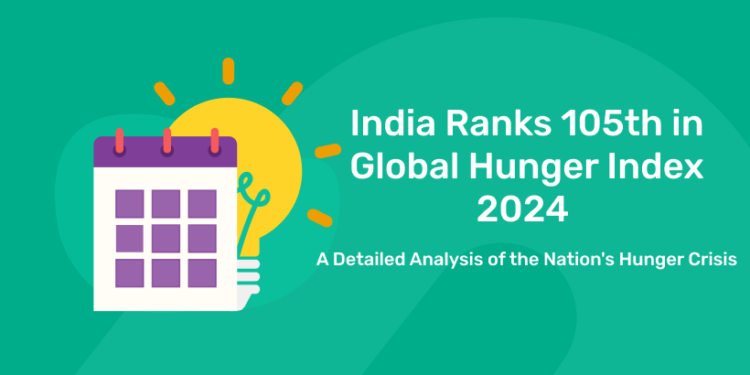Table of Contents
The Global Hunger Index (GHI) 2024 released by Concern Worldwide and Welthungerhilfe has put India at 105th position out of 127 countries. And it has classified the country as “serious”. This has set off alarm bells across the country and we are talking about what needs to be done to improve food security and nutrition in India. Despite being one of the largest economies in the world, India still faces huge challenges of malnutrition and undernutrition.
This year’s GHI score for India is 27.3 which shows the country is still struggling with undernutrition, child stunting, wasting and child mortality. Other South Asian countries like Bangladesh, Nepal and Sri Lanka have done better in the index and fall in the “moderate” hunger category. This shows the stark contrast in the region.
What is Global Hunger Index ?
GHI is a tool to measure hunger and malnutrition globally. It looks at four indicators:
- Undernourishment: Percentage of the population with insufficient caloric intake.
- Child Wasting: Proportion of children under five with low weight for their height, acute undernutrition.
- Child Stunting: Proportion of children under five with low height for their age, chronic undernutrition.
- Child Mortality: Mortality rate of children under five, impact of malnutrition on child survival.
The index is scored on a 100 point scale where 0 is no hunger and 100 is the worst. India’s 27.3 score puts it in the “serious” category and raises concerns about the food insecurity faced by millions of people in the country.
India’s Performance in Global Hunger Index 2024
1: Who was the first woman President of India?
In 2024 GHI, India’s score is 27.3 which is “serious” level of hunger. A closer look at the four components of GHI shows:
- 13.7% of the population is undernourished, a large section of the population does not have access to enough caloric intake.
- 35.5% of children under five are stunted, long term malnutrition affecting physical and cognitive development.
- 18.7% of children under five are wasted, alarming rate of acute malnutrition.
- Child mortality rate is 2.9%, impact of malnutrition on health outcomes.
This shows the need for immediate policy action. India has done well in other areas like economic growth and technology but hunger and nutrition is still a problem.
Free UPSKILLING Courses!
Take your first step toward mastering in-demand skills, acing interviews, and securing top-tier jobs with Entri's free upskilling courses.
Start Learning!Comparing India with Neighbours in Global Hunger Index
India ranks 105 in GHI which is behind many of its South Asian neighbours:
- Bangladesh which has its own struggles with poverty and food insecurity ranks higher in the index. It is because it does better in child stunting and undernourishment.
- Nepal and Sri Lanka are also above India in the “moderate” category of hunger. Both have done better child nutrition programmes in recent years and have made more progress in reducing malnutrition.
Pakistan and Afghanistan are with India in the “serious” category which means the region as a whole has deep rooted problems of food insecurity and child malnutrition. But India has the largest population, so more people are affected, making the situation even more critical.
Reasons for India’s Hunger Crisis
India’s hunger and malnutrition problem is a result of a combination of factors. Some of the key reasons are:
- Poverty and Inequality: A large section of the population is below the poverty line and has limited access to nutritious food. Economic inequality makes the problem worse by unevenly distributing wealth and resources across the population.
- Agriculture and Climate Change: Despite being an agrarian country, India has problems with agricultural productivity mainly due to outdated farming methods and climate change. Erratic weather patterns, droughts and floods have affected food production and distribution.
- Food Distribution and Policy: While government initiatives like PDS and Mid-Day Meal Scheme have helped to address hunger at the grassroots level. Implementation challenges, corruption and inefficiencies have hindered their impact. Lack of focus on child nutrition programmes has also affected the health of young children and resulted in high rates of stunting and wasting.
- Urbanisation and Lifestyle Changes: As India urbanises rapidly, lifestyle and dietary changes have also contributed to undernourishment and malnutrition. Poor urban planning, slum development and lack of access to affordable healthy food in urban areas has made the problem worse.
Government Initiatives to Address Hunger
India has launched several initiatives to address hunger and malnutrition. Some of them are:
- National Food Security Act (NFSA): Enacted in 2013 this act provides subsidised food grains to about two thirds of India’s population. The scheme has helped to reduce hunger in vulnerable population.
- Poshan Abhiyaan (National Nutrition Mission): Launched in 2018 this mission aims to improve nutritional outcomes for children, pregnant women and lactating mothers. It aims to reduce stunting, wasting and anaemia through multi-sectoral approach involving health, education and agriculture sectors.
- Mid-Day Meal Scheme: This scheme provides free lunch to school children across the country and helps to combat child hunger and improve educational outcomes.
- Pradhan Mantri Garib Kalyan Anna Yojana (PMGKAY): Launched during the COVID-19 pandemic, this scheme provided free food grains to over 800 million people. It aimed to counter the food insecurity caused by the pandemic-induced lockdowns.
Free UPSKILLING Courses!
Take your first step toward mastering in-demand skills, acing interviews, and securing top-tier jobs with Entri's free upskilling courses.
Start Learning!What Needs to Change?
While these initiatives are good, the 2024 Global Hunger Index results show we need to do more to tackle the root of hunger in India. Here’s what:
- Boost Agricultural Productivity: India needs to invest in modern farming methods, irrigation and climate resilient crops to boost productivity and food security.
- Fix the Food Distribution System: The Public Distribution System needs to be more transparent and efficient to reduce wastage and corruption. Technology can help in tracking and distribution of food grains.
- Focus on Child Nutrition: Special focus needs to be on child nutrition programs. We need more investment in child healthcare, including immunizations, nutrition supplements, and clean water access, to reduce stunting and wasting.
- Address Climate Change: With climate change being a major reason for food insecurity, India needs to invest in sustainable farming. It can reduce carbon emissions to mitigate the impact of erratic weather patterns.
Conclusion
The 2024 Global Hunger Index shows India still has a long way to go in ensuring food security and tackling malnutrition. Despite progress in other areas of development, India’s 105th rank in the Global Hunger Index is a stark reminder that hunger is still a big problem. We need to collectively act from government and civil society to address the root causes of hunger and undernutrition. Food security is not just about feeding the population. It’s about long term health, growth and well-being for all, especially the most vulnerable sections of society.
Related Articles
Free UPSKILLING Courses!
Take your first step toward mastering in-demand skills, acing interviews, and securing top-tier jobs with Entri's free upskilling courses.
Start Learning!Frequently Asked Questions
What is India's rank in the Global Hunger Index 2024?
India ranks 105th out of 127 countries in the Global Hunger Index 2024, categorised under the “serious” hunger level.
How is the Global Hunger Index calculated?
The GHI is calculated using four indicators: undernourishment, child stunting, child wasting, and child mortality, which are combined to give a score ranging from 0 (best) to 100 (worst).
Why is India’s hunger level still high despite economic growth?
India’s hunger issue is driven by factors such as poverty, inequality, climate change, outdated agricultural practices, and inefficiencies in food distribution systems. Despite economic growth, these factors prevent equitable food access and nutrition.
What are the major challenges contributing to hunger in India?
Major challenges include poverty, agricultural inefficiencies, climate change, poor implementation of food programs, and rising inequality. High rates of child malnutrition in terms of stunting and wasting further exacerbate the crisis.
What needs to be done to improve India’s ranking in the Global Hunger Index?
Improving agricultural productivity, better implementation of food distribution systems, focusing on child nutrition, and addressing the impacts of climate change are key steps needed to improve India’s hunger status.
What percentage of children in India suffer from stunting and wasting?
According to the GHI 2024, 35.5% of children in India suffer from stunting, and 18.7% suffer from wasting, both indicative of chronic and acute malnutrition.
What is the child mortality rate in India according to the GHI 2024?
The child mortality rate in India is 2.9%, reflecting the serious impact of hunger and malnutrition on children under five years old.












